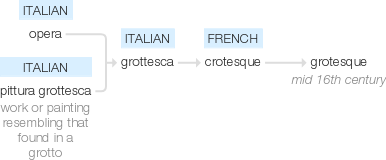Grotesque
mid 16th century (as noun): from French crotesque (the earliest form in English), from Italian grottesca, from opera or pittura grottesca ‘work or painting resembling that found in a grotto’; ‘grotto’ here probably denoted the rooms of ancient buildings in Rome which had been revealed by excavations, and which contained murals in the grotesque style.
wiktionary
From Middle French grotesque (French grotesque), from Italian grottesco(“of a cave”), from grotta. Compare English grotto.
etymonline
grotesque (adj.)
"wildly formed, of irregular proportions, boldly odd," c. 1600s, originally a noun (1560s), from French crotesque (16c., Modern French grotesque), from Italian grottesco, literally "of a cave," from grotta (see grotto). The explanation that the word first was used of paintings found on the walls of Roman ruins revealed by excavation (Italian pittura grottesca) is "intrinsically plausible," according to OED. Originally merely fanciful and fantastic, the sense became pejorative, "clownishly absurd, uncouth," after mid-18c. As the British name for a style of square-cut, sans-serif letter, from 1875. Related: Grotesquely; grotesqueness.
